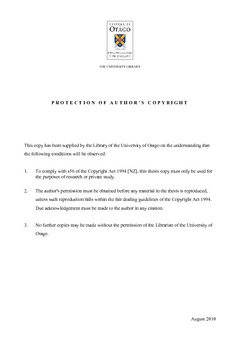OUR Archive is not currently accepting deposits from staff or students due to the upcoming migration to a new system. The new OUR Archive system will be available for thesis deposits on 1 May.
Residential development and environmental weeds in indigenous forest patches, Otatara, Southland
| dc.contributor.advisor | Holland, Peter | |
| dc.contributor.author | Hawcroft, Amy Laura | |
| dc.date.available | 2019-03-18T22:30:47Z | |
| dc.date.copyright | 2002-08-24 | |
| dc.identifier.citation | Hawcroft, A. L. (2002, August 24). Residential development and environmental weeds in indigenous forest patches, Otatara, Southland (Thesis, Master of Science). University of Otago. Retrieved from http://hdl.handle.net/10523/9114 | en |
| dc.identifier.uri | http://hdl.handle.net/10523/9114 | |
| dc.description.abstract | Residential development is widely perceived as a threat to indigenous vegetation and habitat. New Zealand lowland forests, which have been extensively fragmented and modified since colonisation, may be particularly vulnerable. Increased exotic plant invasion of forest remnants is a potential result of nearby residential development. Environmental weeds cause loss of biodiversity at genetic to ecosystem levels of organisation. The impact of residential development was examined in podocarp forest remnants in a matrix of rural and residential land at Otatara, Southland. Correlation between abundance of exotic plants and population density or degree of development has been observed at coarse scales in many areas but few studies have examined mechanisms underlying this pattern. Residential development is thought to exacerbate weed invasion by increasing the likelihood of exotic plant propagules entering forest remnants and by changing conditions within the forest to aid exotic plant establishment and growth. Field data was collected along transects from the forest edge into the interior for 13 study sites at Otatara. The abundance of environmental weeds was quantified at intervals along each transect. Indicators of the spatial context: distance of each quadrat from the forest edge; age of residential development and number of known weed species growing on the adjoining property, and edge structure and three environmental characteristics of the forest: light availability, soil fertility and degree of anthropogenic disturbance, were also assessed. The field data was examined using bivariate correlation analysis and multivariate regression. Weed abundance within forest was significantly correlated to light availability, degree of anthropogenic disturbance, and to distance in from the forest edge and edge structure. Even though a significant correlation was not found between weed abundance and age of residential development (perhaps because of the small scale at which this research was conducted), the factors that are correlated to weed abundance are altered by residential development in ways expected to facilitate weed invasion. Thus, it seems likely that nearby residential development exacerbates weed invasion. Maintaining a relatively closed edge structure and minimising disturbance within forest may lessen this effect. | en_NZ |
| dc.format.mimetype | application/pdf | |
| dc.language.iso | en | en_NZ |
| dc.publisher | University of Otago | |
| dc.subject | environmental weeds | en_NZ |
| dc.subject | urbanisation | en_NZ |
| dc.subject | landscape ecology | en_NZ |
| dc.subject | forest fragmentation | en_NZ |
| dc.subject | Southland, New Zealand | en_NZ |
| dc.title | Residential development and environmental weeds in indigenous forest patches, Otatara, Southland | en_NZ |
| dc.type | Thesis | en_NZ |
| dc.date.updated | 2019-03-18T22:30:27Z | |
| thesis.degree.discipline | Geography | en_NZ |
| thesis.degree.name | Master of Science | en_NZ |
| thesis.degree.grantor | University of Otago | en_NZ |
| thesis.degree.level | Masters | en_NZ |
| otago.openaccess | Open | en_NZ |
| dc.identifier.wikidata | Q112857646 | |
| otago.wikidata.url | https://www.wikidata.org/wiki/Q112857646 |
Files in this item
This item appears in the following Collection(s)
-
School of Geography [1415]
-
Thesis - Masters [4591]

